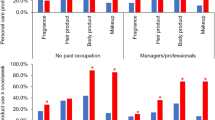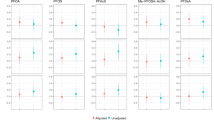Abstract
Polybrominated diphenyl ethers (PBDE) are flame retardants that were previously used in upholstery, fabrics, and household appliances. PBDEs have been linked to adverse health outcomes, including neurotoxicity, thyroid hormone dysregulation, endocrine disruption, and poor semen quality. Because PBDEs pass into placental circulation, maternal exposures can approximate fetal exposures. Our objectives were to determine whether diet and specific human behaviors were significantly associated with PBDE exposures in a cohort of pregnant women. Women between the 34th and 38th week of pregnancy were given a questionnaire about behavioral, environmental, and dietary factors and asked to provide blood samples. Serum PBDE levels were measured using GS-MS and lipid adjusted. An adjusted ordinary least squares regression model was run to identify potential associations between behaviors and serum PBDE levels. Serum concentrations of BDEs 47, 99, 100, and 153 were found above the limit of detection in at least 50% of study participants and used in our models. Associations with serum PBDEs were observed with self-reported hand-to-mouth behaviors, including biting nails and licking fingers. Serum BDE levels of 47, 99, 153, and total PBDEs were also significantly higher in those individuals owning a large-screen TV compared with those who did not. Serum PBDE levels were comparable to levels reported in the general population. Hand-to-mouth behaviors may influence serum PBDE concentrations in adults. Household electronics such as large-screen TVs appear to serve as a significant source of PBDEs in pregnant women. Together, hand-to-mouth behaviors and TV ownership may serve as a route of exposure to PBDEs in adults.
This is a preview of subscription content, access via your institution
Access options
Subscribe to this journal
Receive 6 print issues and online access
$259.00 per year
only $43.17 per issue
Buy this article
- Purchase on Springer Link
- Instant access to full article PDF
Prices may be subject to local taxes which are calculated during checkout
Similar content being viewed by others
References
Harrad S., and Hunter S. Concentrations of polybrominated diphenyl ethers in air and soil on a rural-urban transect across a major UK conurbation. Environ Sci Technol 2006: 40 (15): 4548–4553.
Sjodin A., Wong L.Y., Jones R.S., Park A., Zhang Y., and Hodge C., et al. Serum concentrations of polybrominated diphenyl ethers (PBDEs) and polybrominated biphenyl (PBB) in the United States population: 2003–2004. Environ Sci Technol 2008b: 42 (4): 1377–1384.
Zhang X., Diamond M.L., Robson M., and Harrad S. Sources, emissions, and fate of polybrominated diphenyl ethers and polychlorinated biphenyls indoors in toronto, Canada. Environ Sci Technol 2011: 45 (8): 3268–3274.
Alaee M., Arias P., Sjodin A., and Bergman A. An overview of commercially used brominated flame retardants, their applications, their use patterns in different countries/regions and possible modes of release. Environ Int 2003: 29 (6): 683–689.
Darnerud P.O., Eriksen G.S., Johannesson T., Larsen P.B., and Viluksela M. Polybrominated diphenyl ethers: occurrence, dietary exposure, and toxicology. Environ Health Perspect 2001: 109 (Suppl 1): 49–68.
WHO. Environmental Health Criteria 162, Brominated Diphenyl Ethers; International Program on Chemical Safety. WHO, Geneva, Switzerland, 1994.
Christensen J.H., and Platz J. Screening of polybrominated diphenyl ethers in blue mussels, marine and freshwater sediments in Denmark. J Environ Monit 2001: 3 (5): 543–547.
Klosterhaus S.L., Dreis E., and Baker J.E. Bioaccumulation kinetics of polybrominated diphenyl ethers from estuarine sediments to the marine polychaete, Nereis virens. Environ Toxicol Chem 2011: 30 (5): 1204–1212.
Lacorte S., Guillamon M., Martinez E., Viana P., and Barcelo D. Occurrence and specific congener profile of 40 polybrominated diphenyl ethers in river and coastal sediments from Portugal. Environ Sci Technol 2003: 37 (5): 892–898.
Law D.C. Spatial mixture relative risk models applied to disease mapping. A. B. Lawson and A. Clark, Statistics in Medicine 2002; 21: 359–370. Stat Med 2003: 22: 1202–1203; author reply 1203.
Lim D.H., and Lastoskie C.M. A dynamic multimedia environmental and bioaccumulation model for brominated flame retardants in Lake Huron and Lake Erie, USA. Environ Toxicol Chem 2011: 30 (5): 1018–1025.
Abdelouahab N., Ainmelk Y., and Takser L. Polybrominated diphenyl ethers and sperm quality. Reprod Toxicol 2011: 31 (4): 546–550.
Chen A., Chung E., Defranco E.A., Pinney S.M., and Dietrich K.N. Serum PBDEs and age at menarche in adolescent girls: analysis of the National Health and Nutrition Examination Survey 2003–2004. Environ Res 2011: 111 (6): 831–837.
Chevrier J., Harley K.G., Bradman A., Gharbi M., Sjodin A., and Eskenazi B. Polybrominated diphenyl ether (PBDE) flame retardants and thyroid hormone during pregnancy. Environ Health Perspect 2010: 118 (10): 1444–1449.
He P., He W., Wang A., Xia T., Xu B., and Zhang M., et al. PBDE-47-induced oxidative stress, DNA damage and apoptosis in primary cultured rat hippocampal neurons. Neurotoxicology 2008: 29 (1): 124–129.
He P., Wang A., Niu Q., Guo L., Xia T., and Chen X. Toxic effect of PBDE-47 on thyroid development, learning, and memory, and the interaction between PBDE-47 and PCB153 that enhances toxicity in rats. Toxicol Ind Health 2011: 27 (3): 279–288.
He P., Wang A.G., Xia T., Gao P., Niu Q., and Guo L.J., et al. Mechanisms underlying the developmental neurotoxic effect of PBDE-47 and the enhanced toxicity associated with its combination with PCB153 in rats. Neurotoxicology 2009: 30 (6): 1088–1095.
Herbstman J.B., Sjodin A., Kurzon M., Lederman S.A., Jones R.S., and Rauh V., et al. Prenatal exposure to PBDEs and neurodevelopment. Environ Health Perspect 2010: 118 (5): 712–719.
Stapleton H.M., Eagle S., Anthopolos R., Wolkin A., and Miranda M.L. Associations between polybrominated diphenyl ether (PBDE) flame retardants, phenolic metabolites, and thyroid hormones during pregnancy. Environ Health Perspect 2011: 119 (10): 1454–1459.
Verner M.A., Bouchard M., Fritsche E., Charbonneau M., and Haddad S. In vitro neurotoxicity data in human risk assessment of polybrominated diphenyl ethers (PBDEs): overview and perspectives. Toxicol In Vitro 2011: 25 (8): 1509–1515.
UNEP. 2009. The nine new POPs. An introduction to the nine chemicals added to the Stockholm Convention by the Conference of the Parties at its fourth meeting. Available: http://chm.pops.int/Programmes/newpops/publications/tabid/695/language/en-US/default.aspx. Accessed 14 July 2011.
Tullo A. Flame-retardant phaseout. Chem Eng News 2003: 18: 10–13.
Bromine Science Environmental Forum (BSEF). Legislation – Regulatory Overview in the EU. Available at http://www.bsef.com/regulation/eu_legislation/. Accessed 14 July 2011. 2009.
Bocio A., Llobet J.M., Domingo J.L., Corbella J., Teixido A., and Casas C. Polybrominated diphenyl ethers (PBDEs) in foodstuffs: human exposure through the diet. J Agric Food Chem 2003: 51 (10): 3191–3195.
Domingo J.L. Human exposure to polybrominated diphenyl ethers through the diet. J Chromatogr A 2004: 1054 (1–2): 321–326.
Harrad S., Wijesekera R., Hunter S., Halliwell C., and Baker R. Preliminary assessment of U.K. human dietary and inhalation exposure to polybrominated diphenyl ethers. Environ Sci Technol 2004: 38 (8): 2345–2350.
Kiviranta H., Ovaskainen M.L., and Vartiainen T. Market basket study on dietary intake of PCDD/Fs, PCBs, and PBDEs in Finland. Environ Int 2004: 30 (7): 923–932.
Frederiksen M., Vorkamp K., Thomsen M., and Knudsen L.E. Human internal and external exposure to PBDEs — a review of levels and sources. Int J Hyg Environ Health 2009: 212 (2): 109–134.
Johnson P.I., Stapleton H.M., Sjodin A., and Meeker J.D. Relationships between polybrominated diphenyl ether concentrations in house dust and serum. Environ Sci Technol 2010: 44 (14): 5627–5632.
Stapleton H.M., Allen J.G., Kelly S.M., Konstantinov A., Klosterhaus S., and Watkins D., et al. Alternate and new brominated flame retardants detected in U.S. house dust. Environ Sci Technol 2008: 42 (18): 6910–6916.
Gómara B., Herrero L., Ramos J.J., Mateo J.R., Fernández M.A., and Garca J.F., et al. Distribution of polybrominated diphenyl ethers in human umbilical cord serum, paternal serum, maternal serum, placentas, and breast milk from Madrid population, Spain. Environ Sci Technol 2007: 41 (20): 6961–6968.
CDC. Fourth National Report on Human Exposure to Environmental Chemicals 2009. Available http://www.cdc.gov/ExposureReport/. Accessed 14 July 2011. 2009.
Lind Y., Darnerud P.O., Atuma S., Aune M., Becker W., and Bjerselius R., et al. Polybrominated diphenyl ethers in breast milk from Uppsala County, Sweden. Environ Res 2003: 93 (2): 186–194.
Sjodin A., Wong L.Y., Jones R.S., Park A., Zhang Y., and Hodge C., et al. Serum concentrations of polybrominated diphenyl ethers (PBDEs) and polybrominated biphenyl (PBB) in the united states population: 2003–2004. Environ Sci Technol 2008a: 42 (4): 1377–1384.
Allen J.G., McClean M.D., Stapleton H.M., and Webster T.F. Critical factors in assessing exposure to PBDEs via house dust. Environ Int 2008a: 34 (8): 1085–1091.
Allen J.G., McClean M.D., Stapleton H.M., and Webster T.F. Linking PBDEs in house dust to consumer products using X-ray fluorescence. Environ Sci Technol 2008b: 42 (11): 4222–4228.
Stapleton H.M., Dodder N.G., Offenberg J.H., Schantz M.M., and Wise S.A. Polybrominated diphenyl ethers in house dust and clothes dryer lint. Environ Sci Technol 2005: 39 (4): 925–931.
United States Environmental Protection Agency (USEPA). Exposure factors handbook. Available http://cfpub.epa.gov/ncea/cfm/recordisplay.cfm?deid=12464. Accessed 14 July 2011. 1997.
Allen J.G., McClean M.D., Stapleton H.M., Nelson J.W., and Webster T.F. Personal exposure to polybrominated diphenyl ethers (PBDEs) in residential indoor air. Environ Sci Technol 2007: 41 (13): 4574–4579.
Hazrati S., and Harrad S. Causes of variability in concentrations of polychlorinated biphenyls and polybrominated diphenyl ethers in indoor air. Environ Sci Technol 2006: 40 (24): 7584–7589.
Webster L., Russell M., Adefehinti F., Dalgarno E.J., and Moffat C.F. Preliminary assessment of polybrominated diphenyl ethers (PBDEs) in the Scottish aquatic environment, including the firth of clyde. J Environ Monit 2008: 10 (4): 463–473.
Watkins D.J., McClean M.D., Fraser A.J., Weinberg J., Stapleton H.M., Sjödin A., and Webster T.F. Exposure to PBDEs in the office environment: evaluating the relationships between dust, handwipes, and serum. Environ Health Perspect 2011: 119 (9): 1247–1252.
Choi K.I., Lee S.H., and Osako M. Leaching of brominated flame retardants from TV housing plastics in the presence of dissolved humic matter. Chemosphere 2009: 74 (3): 460–466.
Imm P., Knobeloch L., Buelow C., and Anderson H.A. Household exposures to polybrominated diphenyl ethers (PBDEs) in a Wisconsin Cohort. Environ Health Perspect 2009: 117 (12): 1890–1895.
Thuresson K., Bergman K., Rothenbacher K., Herrmann T., Sjolin S., and Hagmar L., et al. Polybrominated diphenyl ether exposure to electronics recycling workers — a follow up study. Chemosphere 2006: 64 (11): 1855–1861.
Harrad S., and Abdallah M.A. Calibration of two passive air sampler configurations for monitoring concentrations of hexabromocyclododecanes in indoor air. J Environ Monit 2008: 10 (4): 527–531.
Huwe J.K., Hakk H., Smith D.J., Diliberto J.J., Richardson V., Stapleton H.M., and Birnbaum L.S. Comparative absorption and bioaccumulation of polybrominated diphenyl ethers following ingestion via dust and oil in male rats. Environ Sci Technol 2008: 42 (7): 2694–2700.
Acknowledgements
This work was supported by the National Center for Environmental Health, Centers for Disease Control and Prevention. The findings and conclusions in this report are those of the author(s) and do not necessarily represent the views of the Centers for Disease Control and Prevention.
Author information
Authors and Affiliations
Corresponding author
Ethics declarations
Competing interests
The authors declare no conflict of interest.
Rights and permissions
About this article
Cite this article
Buttke, D., Wolkin, A., Stapleton, H. et al. Associations between serum levels of polybrominated diphenyl ether (PBDE) flame retardants and environmental and behavioral factors in pregnant women. J Expo Sci Environ Epidemiol 23, 176–182 (2013). https://doi.org/10.1038/jes.2012.67
Received:
Accepted:
Published:
Issue Date:
DOI: https://doi.org/10.1038/jes.2012.67
Keywords
This article is cited by
-
A review of the success and challenges in characterizing human dermal exposure to flame retardants
Archives of Toxicology (2021)
-
Determination of novel brominated flame retardants and polybrominated diphenyl ethers in serum using gas chromatography–mass spectrometry with two simplified sample preparation procedures
Analytical and Bioanalytical Chemistry (2016)
-
Genetic variation in the CYP2B6 Gene is related to circulating 2,2’,4,4’-tetrabromodiphenyl ether (BDE-47) concentrations: an observational population-based study
Environmental Health (2014)



